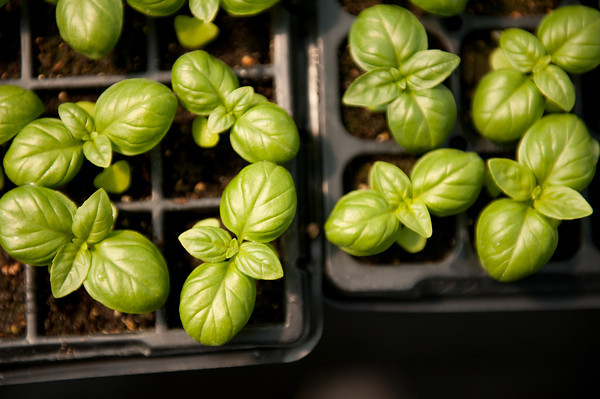
University of Minnesota Agriculture student Ruth Burke is spending this summer interning at a CSA farm called Cramer Organics of Delano, MN. Throughout the growing season, she’ll share weekly updates about the experience with readers of the Heavy Table.
Part 3: “Transplanting 101”
Ah, the joys of transplanting! We are currently in a transplanting blitz at the farm, trying to get everything from the greenhouse into the ground. Once your seedlings are large enough (usually a few inches in height) you can begin to slowly “harden them off.” This means to slowly introduce your greenhouse seedlings to life outdoors. For the first few days, you should bring your seedlings inside overnight, but then you can leave them outside all the time.
After about a week (and this can vary) your transplants should be ready to go in the ground. Make sure that when you transplant them, their new homes have been given plenty of water. You might even mix a small amount of fish emulsion in with your water. (Fish emulsion is essentially fish puree, and its scent is vaguely reminiscent of tuna and worms after a rainstorm — the plants love it!) Also, transplanting should be done as early in the morning as possible. Watering and early morning planting are important because they lessen the effects of transplant shock, which is the inevitable jolt the plant experiences at being taken out of its small plastic home and shoved in the ground.

If you have a large enough farm, you might even have a watering transplanter (which Cramer Organics happens to have). This nifty implement attaches behind a tractor and allows for workers to sit and plant transplants while simultaneously watering them.
Now that you have a little background knowledge of transplanting, let me detail some of the aforementioned joys I have discovered about transplanting:
1. It’s a great lower body and core workout. You have to make sure to balance your upper body so that you don’t strain your back as you bend over to plant the transplants, and thus your core gets lots of exercise. If you kneel in the seats to plant, hamstrings and quads get quite a workout as well.
2. You will get soaked with fish emulsion water and caked with mud. This is simply the nature of the beast. A shower will never feel better than after transplanting!
3. If you’re lucky, you will trade off who gets to drive the tractor. This is a blast! I will write more about learning to use farm equipment next week, but suffice it to say, there is nothing cooler than driving a tractor.
4. At the end of the day, expect to be tired. But, as you look back over your beds (filled with hundreds of plants), expect a feeling of satisfaction from a job well done.
(Visit our full archive of this feature)

Driving a tractor IS cool!!